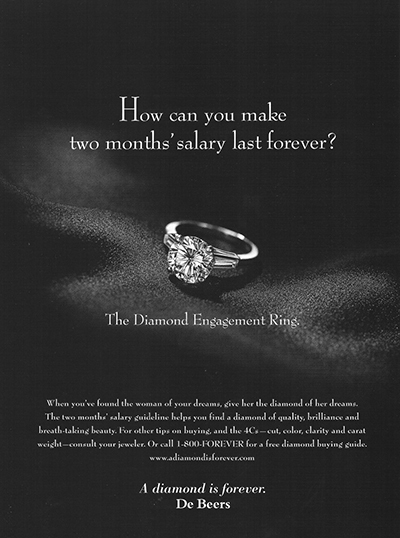DIAMONDS
In 2022, over 2 million engagement rings were sold in the United States. Almost 90% of those rings featured diamonds. That same year, diamond sales made up $340 billion of the global economy. But historically, diamonds were never that popular, and certainly weren't associated with marriage. That cultural shift occurred in the 1940s when one company decided to redefine the marriage proposal.
Diamonds are the hardest, naturally-occurring substances on earth. Early civilizations believed they possessed mystical powers because they seemed indestructible. While they were valued for their beauty and magic, diamonds were primarily used to cut other gems throughout most of history.
Exchanging rings as a pledge of marriage was a common practice dating back to ancient Rome, but most rings contained no gems until the Middle Ages, and then Europeans preferred rubies and sapphires. The first recorded diamond engagement ring was purchased by Archduke Maximilian of Austria in 1477. This set a precedent for the richest members of society, but since diamonds were so rare, they never became a widely accepted choice for any jewelry.
Until the early 1700s, diamonds were only found in India, which was one reason they were so rare. Brazil emerged as another source just as India's supply was dwindling, but 1866 was the year everything changed. In that year, the first diamond was discovered in South Africa, which turned out to house more than ten times the supply of both India and Brazil. Suddenly diamonds weren't as rare as they used to be. In order to control the supply of this newly found resource, all the British-owned mining companies in South Africa merged to form De Beers, which essentially acted as a cartel for the entire diamond industry for over 80 years.
After seizing control of the supply, De Beers was faced with the more daunting task of creating demand where there was none. In 1939, the company set its sights on the United States as the entire world emerged from a global depression. De Beers launched a complex marketing campaign to permanently link love and diamonds in the minds of every American. They provided diamonds to royalty and celebrities, and then worked with publications to create stories that reported on the size and quality of those diamonds. They worked hard to integrate diamonds into movies and popular culture. They organized a nationwide lecture tour of high schools to explain the benefits of diamonds as engagement rings. They began educating the American public on the four Cs (carat, color, clarity, and cut), which had previously only been a secret tool used by the jewelry industry. They defined a value for a diamond engagement ring as one month's salary. And they coined what would ultimately be named the Slogan of the Century: a diamond is forever.

De Beers did all of this without ever promoting its own name or product. No one needed to know who De Beers was. Since it controlled all the diamonds, it profited from all sales. It was more important to create and sustain the allure and mystique of diamonds in general.
The campaign was extraordinarily successful. Before 1939, less than 10% of all engagement rings had diamonds. By 1951, 80% of all brides in America received a diamond ring, and that number has remained constant ever since. By 1979, sales of diamonds in the United States had grown by over 9000%. In 1982, De Beers increased the value of the engagement ring by advertising that men should spend two months' salary. By 2010, the rule of thumb became three months' salary. Interestingly, while De Beers's marketing efforts have clearly shaped our ideas about engagement and marriage, those monetary figures aren't reflected in actual spending. That will be explored this month on our sister podcast, The Data Behind the Business.
After completely changing the United States, De Beers found similar success in other countries, especially Japan, China, and India. But by the beginning of the 21st century, other diamond sources along with weariness of De Beer's stranglehold on the industry led to huge losses in market share. At the height of its empire in 1987, De Beers enjoyed 90% of global diamond sales. In 2002, its market share dropped to 60%, and for the first time in its history, De Beers opened its own store to sell its own product. De Beers's market share in 2022 was only 38%, but it reported $6.6 billion in revenue, its highest ever. It may not control the industry anymore, but its marketing legacy continues every time someone buys a diamond. And it seems like it will endure forever.
SOURCES
- "Diamond History and Lore" from Gemological Institute of America
- "Diamonds: A History" from CBS 60 Minutes
- "Diamonds Timeline" from Galeries Du Diamant
- "The Incredible Story Of How De Beers Created And Lost The Most Powerful Monopoly Ever" from Business Insider
- "How an Ad Campaign Invented the Diamond Engagement Ring" from The Atlantic
- "How Diamonds Became Forever" from The New York Times
- "De Beers - Monopoly Broken" from Australian Diamond Portfolio
- "Diamond Value Chain Dashboard" from De Beers Group













